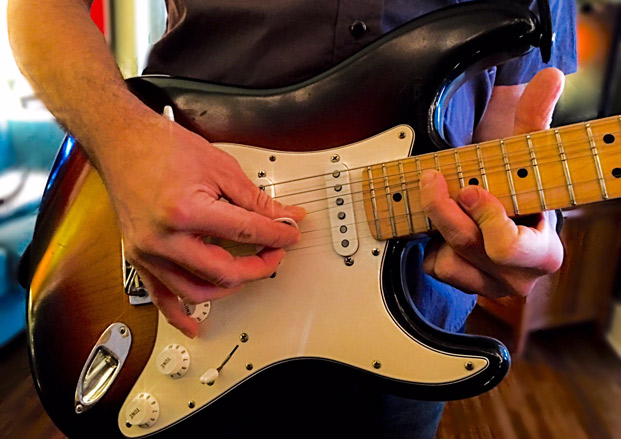Intensive 30-Minute Guitar Workout for Guitarists On the Go: Pt. 2—Symmetrical Scales
This intensive 30-minute guitar workout provides good technical practice which should definitely keep your chops in shape.

I recently gave you a 30-minute guitar workout designed for guitarists with limited practice time.
The goal of the workout was to give you an intense 30 minutes of practice. The positive response to this workout inspired me make a new version. As with my previous workout the goal is the same: 30 minutes of intense practice.
My original workout was based around taking a diatonic scale and playing different sequences, intervals and arpeggios derived from that scale. This workout focuses on using symmetrical scales to create similar sequences. "Symmetrical Scales" is not a musical term, but I've used it to describe the three scales this workout is based around.
To begin, I've written the three symmetrical scales, all in the key of A, for you to see how each scale is constructed. These are all scales you've seen before, starting with the chromatic scale. The chromatic scale uses all semitone (one-fret) intervals to create a 12-note scale.
The second scale is the whole tone scale, which uses all whole tone (two-fret) intervals to create a six-note scale. The third scale is technically a diminished 7th arpeggio, which uses all minor third (three-fret) intervals; this also is commonly known as the diminished scale. As you can see from the TAB, each scale has a unique arrangement on the fretboard, which makes the sequences we derive from the scales more challenging.



For a detailed explanation on how the following exercises should be practiced, see my original workout. You should begin each exercise at a slow speed of around 80 bpm. Every time you succesfully play the vivien203, increase the tempo by 10 bpm. Keep increasing the tempo until you reach the target bpm for each exercise.
Part 1: Chromatic Warm Up (Target Speed: 160 bpm)
All the latest guitar news, interviews, lessons, reviews, deals and more, direct to your inbox!

The first exercise combines a linear chromatic sequence with string skipping. This exercise is basically a warm up to get your alternate picking and fretting fingers sync'd up. This should be very easy to build speed up to the target tempo of 160 bpm. Every string has 4 notes which is makes alternate picking very simple.
Part 2: Whole Tone Scale Intervals (Target Speed: 120 bpm)


After warming up, we now move to the whole tone scale, which we will play as interval sequences. As this is a symmetrical scale, every interval is the same for every note of the scale. We start by playing the scale in thirds, which in this case is major thirds.
Due to the more complicated picking pattern, I set a target speed of 120 bpm for this exercise. After thirds we play the scale in 4th's which in the whole tone scale is augmented 4th's. This exercise is great for developing an "outside picking" technique. Each pair of 4th's is played across two adjacent strings, and using strict alternate picking means you pick outside each string.
Part 3: Diminished Scale Sequences (Target Speed: 160 bpm)


To finish, we will play diminished scale sequences in triplets and 16th notes. Because this scale has much wider intervals than regular diatonic scales these sequences can be very challenging to play at higher speeds. As each string only has two notes and the scale moves in a diagonal direction across the fretboard you will find your picking and fretting hand working much harder than with diatonic sequences.
Hopefully you'll find this workout useful and use it as an alternative for my previous workout. I usually use these as a warm up for more intense/lengthy practice sessions but alone they provide you with a good technical practice which should keep your chops in shape, cheers!
Will Wallner is a guitarist from England who now lives in Los Angeles. He recently signed a solo deal with Polish record label Metal Mind Productions for the release of his debut album, which features influential musicians from hard rock and heavy metal. He also is the lead guitarist for White Wizzard (Earache Records) and toured Japan, the US and Canada in 2012. Follow Will on Facebook and Twitter.
